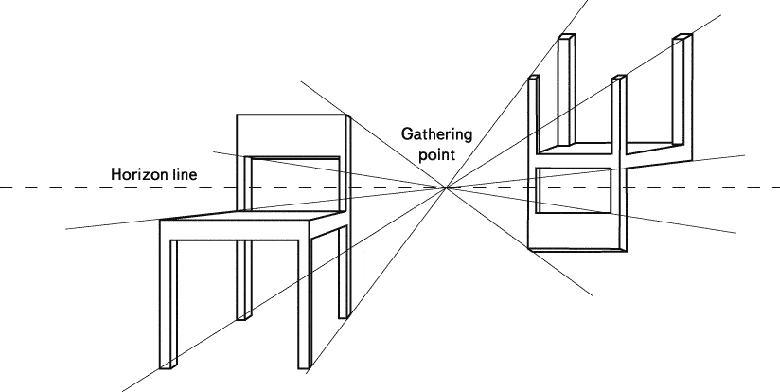As a matter of fact, the ancient Greeks were already familiar with perspectival constructions. The greater popularity of Witelo’s much later and derivative work is thus explained by the fact that Alhacen’s Book of Optics was considered a copy of writings by Ptolemy. We can find reflections on the fact that parallel lines converge as they become more distant from the eyes of the viewer already in the works of Euclid, although he was not yet able to conclude on this basis that they must converge in one point on the horizon. During the Hellenistic period, painters already made full use of the technique of converging lines, although each group of parallel lines had a different vanishing point. The Greek artist saw each object discretely, so to speak. Or, in other words, he viewed his landscape polycentrically, that is, from many points of view simultaneously – from above, from below, from the front, from the side. His gaze was thus dynamic and roaming. Therefore, the theory of linear perspective was essentially only the completion (and a fairly mechanical one at that) of the construction of visually connected space that had been begun by the artists of antiquity.
The task of perspective consisted in creating on the pictorial plane the same conditions in which real objects in real space appear to our sight. The discovery of perspective thus does not constitute a new view of the world (man has always seen things in more or less sequential perspective), but only a certain way of depicting the world, of depicting space as hierarchically subordinated to the gaze of the viewer, who looks through the «window» of the picture.
Only the reverse perspective of Byzantine and ancient Russian art can be considered a genuine revolution. This art situated the celestial world, a world inaccessible to «corporeal» visual perception, at the center of the hierarchy of being. The depiction of theoretical or contemplative space in ancient icon painting was the real revolution in the art, a revolution carried out by Eastern Orthodoxy during the Middle Ages. Moreover, whereas direct perspective, which describes the “visibility” of spatial relations in the real world, is obviously grounded in perception and descriptive geometry, reverse perspective is not in and of itself connected either with rational knowledge or with observation of a holistic picture of the world: as a geometry of visual perception it does not form an independent system. This is probably why the issue of the sources of reverse perspective’s emergence and evolution is so controversial. The Russian literature on this theme usually cites the works of Pavel Florensky, Lev Zhegin, Alexei Losev, and Boris Rauschenbach, whose opinions on the historical background of reverse perspective sometimes radically diverge: from an interpretation of reverse perspective as an illusory projection of space from the viewpoint of the supernatural world that employs Riemannian geometry and Einstein’s theory of relativity (Florensky), to the explanation that ancient icon painting was the result of unmediated perception, the artless drawing of what the artist saw from close up (Rauschenbach). However, if we view the direct and reverse systems of perspective not as opposed to one another, but in their totality, the answer to the question of how reverse perspective emerged in Byzantine and ancient Russian icon painting comes quite naturally.
For the sake of illustration, let us take any object – for example, a chair (which is usually employed as an example in textbooks on perspectival drawing) – and construct its linear perspective. The vanishing point of direct linear perspective is located on the horizon line. Now let us extend the perspective lines beyond the horizon and construct a perspectival image of the same chair, but which is now situated beyond the horizon at the same distance from the vanishing point as the original chair.

We see that beyond the horizon the perspective lines naturally diverge and that the chair, which lies behind the horizon, appears to us in reverse perspective. It turns out that objects situated beyond the horizon, in the supernatural world, can only be observed contemplatively, in reverse perspective. Now it becomes clear where the medieval icon painters, who had perfectly mastered the laws of perspective as already developed by the ancient Greeks, attempted to gaze as they depicted the celestial world. It is now clear that the return of artists during the Renaissance to direct linear perspective was only the loss on their part of the desire to look beyond the horizon. In essence, it was a rejection of interest in the Divine world. It was spiritual nearsightedness, a step backwards in spiritual development. It is thus clear why Pavel Florensky argued that direct perspective and reverse perspective are the antipodes of artistic thinking. They are two different cultures, one of which he called «contemplatively creative», the other, «predatorily mechanical».
In conclusion, perhaps the tragic fundamental cultural divide of the "new age" can be bridged by restoring the integrity of the perspective system of the artistic worldview. It is a rather complicated path, but it seems to me that post-secular society is moving in this direction. Or at least I would like to think so. At any rate, the dialogue between the Church and contemporary art that I have been trying to develop since the formulation of the above hypothesis serves precisely this task.
NOTE. The above illustration of the scheme of the genesis of the reverse perspective of artistic representation emphasizes the peculiarities of the speculative space of the Kingdom of Heaven, in which the highest position is obtained by those who in the world seek to occupy the lowest. And the latter here become the former there.
Gor Chahal. Moscow, 2010-23.